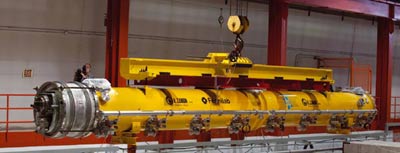When complete, the prototype accelerator will comprise six cryomodules like this first example. Each weighs about 8 tonnes and contains eight SRF cavities. (Courtesy Fermilab Visual Media Services.)

Image credit: Fermilab Visual Media Services.
Fermilab has announced the start of phase II of the construction of a new facility to advance superconducting RF (SRF) technology. The facility, which will host a 140 m-long test accelerator, will be the first of its kind in the US.
Construction of the SRF Accelerator Test Facility is part of Fermilab’s SRF R&D programme, which it is advancing with $52.7 m in funding from the American Recovery and Reinvestment Act (ARRA). Phase I of the construction began in March with the $2.8 m expansion of an existing building. For phase II, the laboratory has awarded a contract worth $4.2 m for the construction of two new buildings. Additional ARRA funds will go towards equipment and infrastructure that are needed for the building’s operation.
The new facility will allow Fermilab to test SRF components and validate the manufacturing capability of vendors from US industry. The superconducting structures operate at low temperatures inside cryomodules and the plans are to test modules designed for two projects for future accelerators: Project X, a high-intensity proton accelerator complex that would be built at Fermilab, and the International Linear Collider, an electron–positron collider that could become the world’s next high-energy machine, designed and built through an international effort. Researchers will also use the particle beams generated by the test accelerator to help them develop instruments and accelerator technology for application in other fields, including medicine and industry.
Barton Malow Inc, a company based in Michigan, will do the civil construction for the new facility. This will consist of three interconnected structures: one will house the SRF test accelerator; the second will accommodate the area for testing cryomodules; and the third will house the equipment for a powerful new cryogenic plant to cool the cryomodules in the test accelerator and the test area. The company plans to finish the project by autumn 2011.








